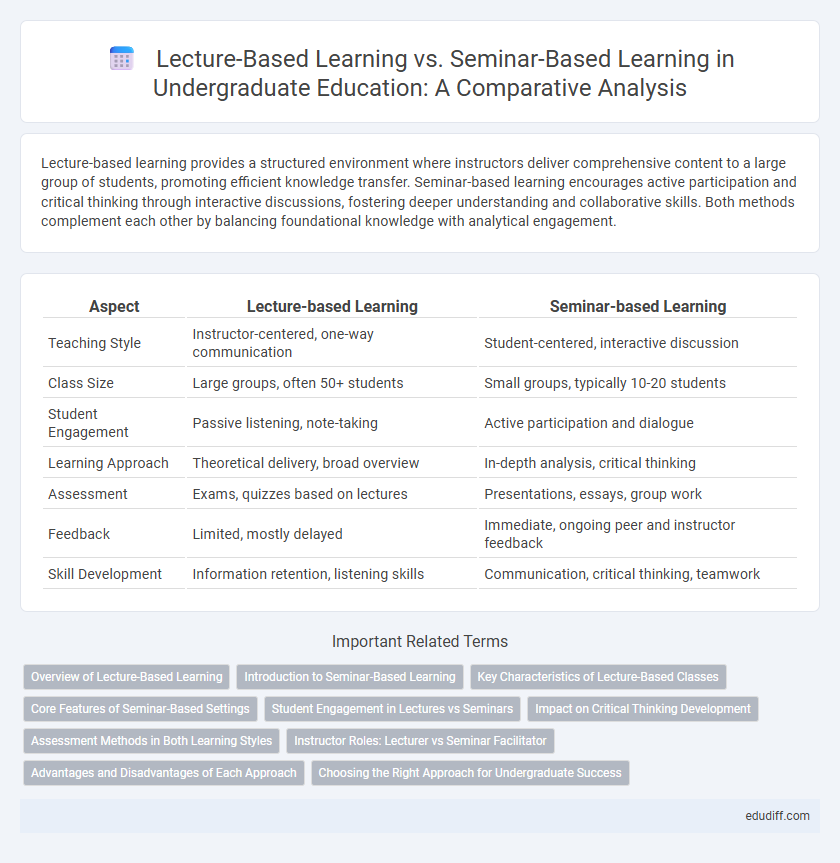Lecture-based learning provides a structured environment where instructors deliver comprehensive content to a large group of students, promoting efficient knowledge transfer. Seminar-based learning encourages active participation and critical thinking through interactive discussions, fostering deeper understanding and collaborative skills. Both methods complement each other by balancing foundational knowledge with analytical engagement.
Table of Comparison
| Aspect | Lecture-based Learning | Seminar-based Learning |
|---|---|---|
| Teaching Style | Instructor-centered, one-way communication | Student-centered, interactive discussion |
| Class Size | Large groups, often 50+ students | Small groups, typically 10-20 students |
| Student Engagement | Passive listening, note-taking | Active participation and dialogue |
| Learning Approach | Theoretical delivery, broad overview | In-depth analysis, critical thinking |
| Assessment | Exams, quizzes based on lectures | Presentations, essays, group work |
| Feedback | Limited, mostly delayed | Immediate, ongoing peer and instructor feedback |
| Skill Development | Information retention, listening skills | Communication, critical thinking, teamwork |
Overview of Lecture-Based Learning
Lecture-based learning emphasizes the structured delivery of content by instructors, facilitating the efficient transmission of foundational knowledge to large groups of undergraduate students. This method prioritizes clarity and organization, often employing multimedia presentations and standardized curricula to enhance comprehension and retention. It supports passive learning but may limit student interaction and critical thinking opportunities compared to seminar-based approaches.
Introduction to Seminar-Based Learning
Seminar-based learning fosters interactive discussions and critical thinking by engaging students directly with course material and peers. Unlike lecture-based learning, which often relies on passive listening, seminar formats encourage active participation, collaboration, and in-depth exploration of topics. This method develops communication skills and promotes a deeper understanding through dialogue and diverse perspectives.
Key Characteristics of Lecture-Based Classes
Lecture-based classes emphasize structured delivery of core content by the instructor, facilitating large group teaching with minimal student interaction. Key characteristics include a fixed syllabus, predetermined pace, and reliance on note-taking and listening for knowledge acquisition. This format supports efficient dissemination of foundational theories and concepts essential for undergraduate courses.
Core Features of Seminar-Based Settings
Seminar-based learning emphasizes active student participation, fostering critical thinking through discussion and debate rather than passive information absorption typical of lecture-based formats. Core features include small group interactions, collaborative knowledge construction, and personalized feedback, which enhance deeper understanding and skill development. This method encourages diverse perspectives and analytical skills essential for complex problem-solving in undergraduate education.
Student Engagement in Lectures vs Seminars
Lecture-based learning often results in lower student engagement due to its primarily passive format, where students listen rather than actively participate. In contrast, seminar-based learning fosters higher engagement through interactive discussions, critical thinking, and collaborative problem-solving among undergraduates. Research indicates that seminars enhance comprehension and retention by encouraging student involvement and immediate feedback.
Impact on Critical Thinking Development
Lecture-based learning primarily delivers structured information, which can limit opportunities for students to actively engage and critically analyze content. Seminar-based learning encourages dialogue, questioning, and collaborative exploration, significantly enhancing critical thinking development by exposing students to diverse perspectives. Research indicates that students participating in seminars demonstrate higher proficiency in reasoning, problem-solving, and synthesizing complex ideas compared to those relying solely on lectures.
Assessment Methods in Both Learning Styles
Lecture-based learning primarily uses written exams and quizzes to assess students' comprehension of theoretical content, emphasizing individual recall and understanding. Seminar-based learning employs presentations, group projects, and class participation as assessment methods, fostering critical thinking, collaboration, and practical application of knowledge. Both methods align assessments with their instructional goals, where lectures focus on content retention and seminars emphasize discussion-based learning and analytical skills.
Instructor Roles: Lecturer vs Seminar Facilitator
Lecture-based learning centers on the lecturer as the primary knowledge provider, delivering structured content to large groups with limited student interaction. Seminar-based learning emphasizes the seminar facilitator's role in guiding dialogue, encouraging critical thinking, and fostering collaborative exploration among smaller student groups. This shift from information transmission to interactive engagement enhances deeper understanding and active learning in undergraduate education.
Advantages and Disadvantages of Each Approach
Lecture-based learning offers efficient delivery of comprehensive content to large groups, enabling standardized knowledge transfer but may limit student engagement and critical thinking. Seminar-based learning fosters interactive discussions and deeper understanding through active participation, promoting critical analysis though it can be time-consuming and less structured. Balancing the advantages of lectures' scalability with seminars' interactive benefits can optimize undergraduate educational outcomes.
Choosing the Right Approach for Undergraduate Success
Lecture-based learning provides a structured delivery of core concepts ideal for large undergraduate classes, ensuring comprehensive coverage of essential material. Seminar-based learning fosters critical thinking and active participation through small group discussions, enhancing deeper understanding and engagement. Selecting the right approach depends on the course objectives, with lectures suited for foundational knowledge and seminars for analytical skills development.
Lecture-based Learning vs Seminar-based Learning Infographic

 edudiff.com
edudiff.com